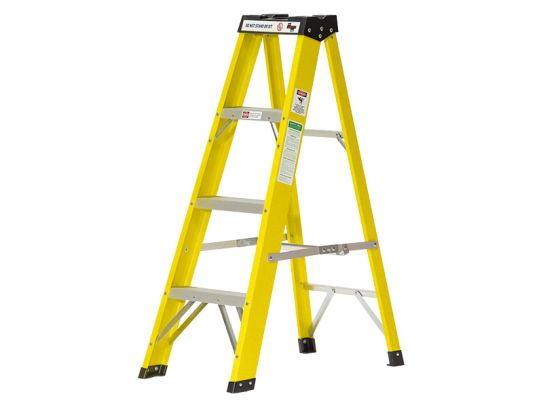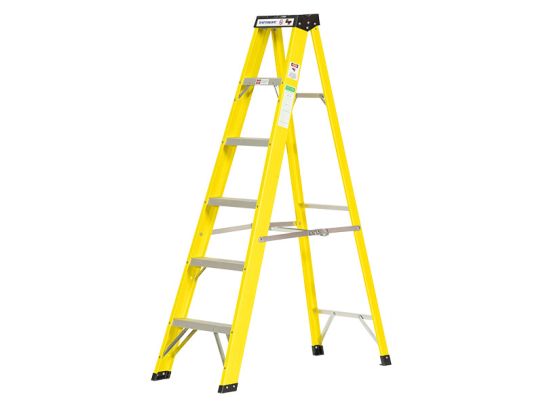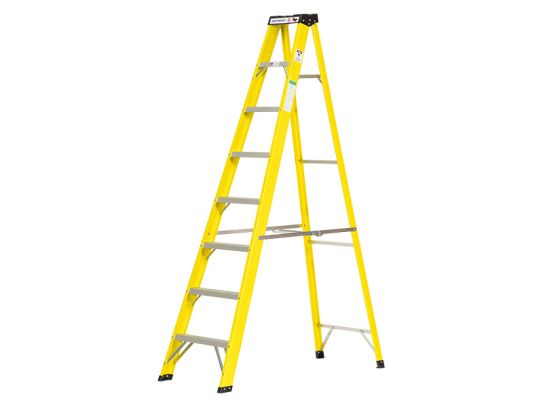Fibreglass Step Ladders
Reach New Heights With Our Fibreglass Step Ladders
Step up to the ultimate in safety and stability with our range of fibreglass step ladders! Whether you're a professional contractor or a DIY enthusiast, our ladders are built to last and handle even the toughest jobs.
With a choice of A-Frame and platform ladders, in sizes from 3 to 8 treads, and available in vibrant red or yellow, you'll find the perfect ladder for your needs. Plus, with a load capacity of 360kg, you can trust that our ladders will hold up to whatever you need to accomplish.
But we don't just stop at durability. Our ladders feature integrated trays for storage of tools and paint cans, anti-slip rubber-covered feet, slip-resistant steps, cross-linked metal side-stays to enhance stability, and metal braces fitted under the treads support, ensuring that you can work confidently and safely.
What Are Fibreglass Step Ladders?
Fibreglass step ladders are a type of ladder that are made from a combination of glass fibres and a plastic resin. They are commonly used for both industrial and residential applications because of their durability, strength and resistance to extreme temperatures, chemicals and electrical current. They are also non-conductive which makes them a safe choice for electrical work. They are also lightweight and easy to move around, and can be made in a variety of sizes and styles, including A-frame and platform ladders.
What Are Some Common Uses for Fibreglass Step Ladders?
Fibreglass step ladders are commonly used for a variety of tasks, both in industrial and residential settings. Some of the most common uses include:
- Electrical work: The non-conductive properties of fibreglass make these ladders a safe choice for electrical work, as they do not conduct electricity and will not interfere with electrical equipment.
- Painting and decorating: The slip-resistant steps and the ability to hold tools and paint cans make it easy to paint and decorating.
- Industrial settings: They are often used in factories, warehouses and other industrial settings due to their durability and resistance to extreme temperatures, chemicals and electrical current.
- Construction: They are often used by builders, contractors, and other construction professionals to reach high spaces and for painting, and other tasks that require stability and support.
- Home maintenance and DIY projects: They are also commonly used for home maintenance tasks such as changing light bulbs, cleaning gutters, and other tasks that require reaching high spaces.
What Are the Different Types of Fibreglass Step Ladders?
There are several different types of fibreglass step ladders, each designed for specific tasks and environments. Some of the most common types include:
- A-Frame ladders: These ladders have two sections that form an "A" shape, with the steps on one side and the support on the other. They are usually lightweight and easy to move around, making them a popular choice for both residential and commercial use.
- Platform ladders: These ladders have a wide platform at the top, providing a stable and secure working surface. They are often used for tasks that require a stable work surface, such as painting, electrical work, and other tasks that require a steady hand.
- Extension ladders: These ladders can be adjusted to different lengths and are commonly used for tasks that require reaching high spaces such as cleaning gutters, changing light bulbs, and other tasks that require reaching high spaces.
- Multi-position ladders: These ladders can be adjusted and used in multiple positions, such as A-frame, extension, and step ladder. They are versatile and can be used for a variety of tasks.
What Are the Key Features to Consider When Choosing Fibreglass Step Ladders?
When choosing a fibreglass step ladder, there are several key features to consider to ensure that you select a ladder that meets your needs and provides the safety and stability you require.
- Size and weight capacity: Consider the size of the ladder and the weight capacity it can hold. Make sure to select a ladder that is appropriately sized for the tasks you will be performing and that can hold your weight and any tools or materials you will be carrying.
- Length: Consider the length of the ladder and make sure it is long enough to reach the height you need.
- Stability: Look for features such as slip-resistant steps, cross-linked metal side-stays, and metal braces fitted under the treads support, which enhance the stability of the ladder.
- Safety: Look for features such as non-conductive properties and anti-slip rubber-covered feet, which make the ladder safer to use.
- Versatility: Look for ladders that can be adjusted and used in multiple positions, such as A-frame, extension, and step ladder, so that you can use them for a variety of tasks.
- Convenience: Consider if the ladder has integrated trays for storage of tools and paint cans, or other features that will make your work more efficient and convenient.
- Durability: Look for a ladder that is constructed from high-quality materials and is built to last. Fibreglass ladders are known for their durability and resistance to extreme temperatures, chemicals and electrical current.
What Are the Benefits of a Fibreglass Step Ladder Over Metal or Wood?
There are several benefits to using a fibreglass step ladder over a metal or wood ladder, including:
- Non-conductive properties: Fibreglass ladders are non-conductive, making them safer to use around electricity. This is a very important safety feature for people working in electrical fields.
- Durability: Fibreglass ladders are more durable than wood ladders and are resistant to extreme temperatures, chemicals, and electrical current. This means they can last longer and require less maintenance.
- Lightweight: Fibreglass ladders are typically lighter in weight than metal ladders, making them easier to move around and use for tasks that require frequent ladder repositioning.
- Weather resistance: Fibreglass ladders are resistant to weathering and UV light, so they don't degrade easily when exposed to the sun, rain or cold.
- Safety: Many fibreglass ladders feature slip-resistant steps and anti-slip rubber-covered feet, which enhance the stability and safety of the ladder.
- Convenience: Some fibreglass ladders have integrated trays for storage of tools and paint cans, or other features that can make work more efficient and convenient.
- Environmentally friendly: Fibreglass ladders are made of a glass-reinforced plastic material, which can be recycled or repurposed at the end of its life, making it a more environmentally friendly option than wood or metal ladders.
Are Fibreglass Step Ladders Safe to Use Around Electricity?
Fibreglass step ladders are considered safe to use around electricity because they are non-conductive. The fibres of the glass are insulators which means they do not conduct electricity and this makes them a safer option to use around electrical fields.
However, it is important to note that even non-conductive ladders can become conductive if they come into contact with a power source, such as if they become wet or damaged. Therefore, it is important to ensure that the ladder is dry and in good condition before using it near electricity. It is also important to be aware of your surroundings and to avoid placing the ladder in close proximity to electrical sources, such as power lines, when in use.
Additionally, it is important to always follow safety guidelines and regulations when working near electricity, even if you are using a non-conductive ladder. This includes wearing proper personal protective equipment and following manufacturer guidelines.
How Do You Maintain and Clean Fibreglass Step Ladders?
To properly maintain and clean fibreglass step ladders, you should:
- Clean the ladder regularly: Use a mild detergent and water to clean the ladder, paying special attention to the steps and rungs. Wipe the ladder down with a clean, dry cloth to remove any remaining dirt or grime.
- Check for damage: Inspect the ladder for any signs of damage, such as cracks or breaks in the fibreglass. If you notice any damage, do not use the ladder and contact the manufacturer for repair or replacement.
- Store in a dry, cool place: When not in use, store the ladder in a dry, cool place to prevent warping or damage.
- Keep it away from harsh chemicals: Avoid exposing the ladder to harsh chemicals such as acids, solvents and other corrosive materials, they can damage the fibreglass and weaken the ladder.
- Lubricate the hinges: If your ladder has hinges, lubricate them with a silicone-based lubricant to ensure smooth and easy operation.
- Check the feet: Check the feet of the ladder for wear and tear and replace them if necessary.
- Keep it level: While working, make sure the ladder is level and on firm, stable ground to prevent accidents.
- Follow manufacturer's instructions: Follow the manufacturer's instructions for cleaning, maintenance, and storage of your ladder to ensure that it remains in good working condition and maintains its safety features.
By following these guidelines, you can help ensure that your fibreglass ladder will last for many years and remain safe to use.
What Safety Considerations Should Be Taken Into Account When Using Fibreglass Step Ladders?
When using fibreglass step ladders, it is important to take several safety considerations into account to prevent accidents and injuries:
- Use the right ladder for the job: Make sure the ladder is tall enough and can support the weight you will be placing on it.
- Check for damage: Inspect the ladder for any signs of damage, such as cracks or breaks in the fibreglass. If you notice any damage, do not use the ladder and contact the manufacturer for repair or replacement.
- Secure the ladder: Make sure the ladder is on a stable and level surface, and that it is properly secured to prevent it from slipping or tipping over.
- Use the ladder properly: Make sure you are facing the ladder when climbing up and down, and that you are using the ladder for its intended purpose.
- Limit the weight: Do not exceed the weight limit for the ladder, as it can cause the ladder to break or tip over.
- Keep 3-points of contact: Keep at least three points of contact with the ladder at all times, either with two feet and one hand or two hands and one foot.
- Wear appropriate gear: Wear non-slip shoes and avoid wearing loose clothing or jewellery that can get caught in the ladder.
- Keep the ladder away from electrical sources: Make sure the ladder is a safe distance away from power lines, electrical panels or other electrical sources.
By following these guidelines, you can help ensure that you use your fibreglass ladder safely and prevent accidents and injuries.
Are There Any UK or European Regulations That Apply to Fibreglass Step Ladders?
Yes, there are several industry standards and regulations that apply to fibreglass step ladders in the UK and Europe.
- EN131: This is the European standard for ladders, step ladders, and trestles. It specifies the safety requirements and test methods for ladders, including load capacity, stability, and durability.
- BS EN 131-1:2007: This is the British standard for ladders, step ladders and trestles. It includes requirements for ladder design, materials, construction, testing, and marking.
- The Work at Height Regulations 2005: These regulations set out the legal requirements for work at height in the UK, including the provision and use of work equipment, and the training and competence of those who use it.
It is important to ensure that any fibreglass step ladder you purchase complies with these standards and regulations, and that it is properly maintained and used according to the manufacturer's instructions in order to ensure safety.


